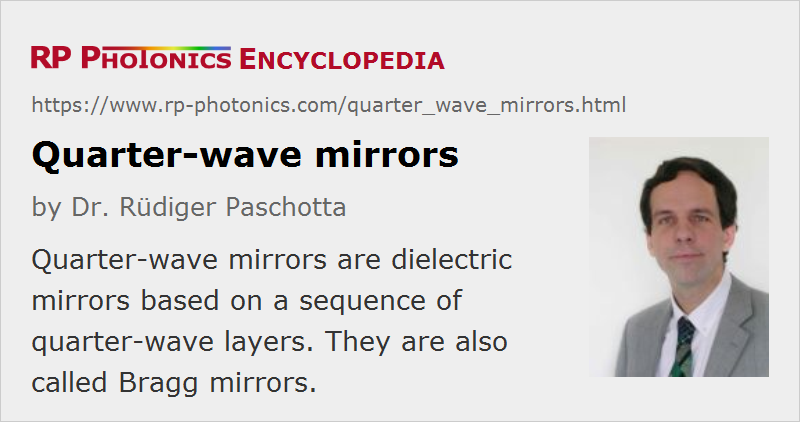Quarter-wave Mirrors
Definition: dielectric mirrors based on a sequence of quarter-wave layers
Alternative term: Bragg mirrors
More general term: dielectric mirrors
How to cite the article; suggest additional literature
Author: Dr. Rüdiger Paschotta
A quarter-wave mirror, also called a Bragg mirror, is a dielectric mirror structure which consists of an alternating sequence of layers of two different optical materials, with each optical layer thickness corresponding to one-quarter of the wavelength for which the mirror is designed (here, the wavelength is taken to be the wavelength within the material, not the vacuum wavelength). For a given wavelength and number of layer pairs, a quarter-wave mirror is the structure which can result in the highest reflectivity.
Quarter-wave stacks are also very basic building blocks of more complicated dielectric mirror structures.
Questions and Comments from Users
Here you can submit questions and comments. As far as they get accepted by the author, they will appear above this paragraph together with the author’s answer. The author will decide on acceptance based on certain criteria. Essentially, the issue must be of sufficiently broad interest.
Please do not enter personal data here; we would otherwise delete it soon. (See also our privacy declaration.) If you wish to receive personal feedback or consultancy from the author, please contact him e.g. via e-mail.
By submitting the information, you give your consent to the potential publication of your inputs on our website according to our rules. (If you later retract your consent, we will delete those inputs.) As your inputs are first reviewed by the author, they may be published with some delay.
See also: Bragg mirrors, dielectric mirrors, chirped mirrors, dispersive mirrors
and other articles in the category photonic devices
 |





If you like this page, please share the link with your friends and colleagues, e.g. via social media:
These sharing buttons are implemented in a privacy-friendly way!